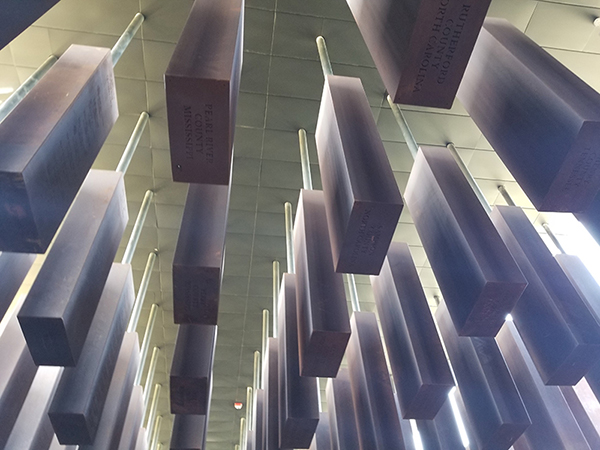Lynching Memorial: The National Memorial for Peace and Justice
Our horrific American past comes to life here at the National Memorial for Peace and Justice. After passing a sculpture by Ghanaian artist Kwame Akoto-Bamfo depicting the trauma of slavery, I entered the open-air memorial to stand face-to-face with our past. A slab of copper-colored material, in the shape of a tombstone, hangs—each placed beside another, in rows and rows, listing the names of those murdered by lynching. As the floor slips away, I begin to realize I’m not standing at eye level any longer, the hanging markers have begun to rise overhead as the floor descends. I am in the position of the perpetrator, looking up as so many had in the past, peering up at their hanging victim. It was sobering. I could no longer read their names. I was part of the mob.

Visiting here when the memorial opened in April 2018, I was flooded with so many emotions and realizations. While I had been immersed over the past several years in learning our American history on lynchings (nudged by a friend who had noticed the gap in my education), I was still overcome with the stark realization of what it means to be part of a nation that killed 4,400 individuals, its own citizens. These human beings were mostly Black and mostly in the South. No murder convictions were ever obtained for the executors.
As I continued around the descending square, I asked myself the questions that every visitor must: Why couldn’t this have been stopped? Where were the authorities? Where were the supportive systems of justice at the time when they were needed most? I then noticed how the markers are organized. They are not grouped alphabetically by victim or by year. Each marker has a collection of names and are grouped by county. Okay, so what were the systems in these counties that could have prevented this? The courts, the jails, the law enforcement, the churches, the chambers of commerce. In order for this genocide to happen over the course of more than fifty years, these systems either had to be, at best, willfully blind or, at worst, complicit. The pressure for individuals to stay silent against these systems must have been incredible.
If I’d had the chance, would I have done something to stop this—to stop even one? I am overcome by the desire to think I would be strong and just as quickly I am stunned by the realization of my own weakness. Societal systems are nothing more than a collection of individuals acting on behalf of the whole. Humans acting together, making decisions in pursuit of collective values and aspirations. How do those systems go so horribly wrong? How are those individuals silenced? Certainly, this could not happen today!
This memorial sits upon a hill, open to the elements, where the breeze is free to roam as the sunshine spills upon our collective sins. Here, the past is hidden no longer but available for everyone to see and to learn and to absorb.
This memorial doesn’t just honor the past, it asks something of its visitors. To learn, to reflect, to probe, to speak, to write, to act. But to what end?
America is not at a loss for its heroes, individuals with a pioneering spirit who conquered the terrains and enemies, foreign and domestic. But what of our ability to examine our collective action and the collective results? And what of a voice, alone and in the wind, that might impact that collective action? Who will speak out? Whose responsibility is it? How will we remember this? How will we prevent it from happening again?
And what is the writer’s responsibility?



Never really took the time to think about this ! Shame on me ! Writers should share using their gifts to help us all understand and keep this from ever happening again ?
Thank you for writing that DENISE. My hope is that everyone examines their own heart and at least start discussing those questions and start the healing that is so desperately needed.